|
National symbols:
The identity of Mother Lanka
The month of February ushers in a day of great national significance
- Independence Day. On February 4, all citizens of Mother Lanka,
irrespective of caste, creed or religion and also where they are
presently domiciled in ,should take pride in the fact that our little
island nation is no longer under foreign rule.
The road to freedom was not easy, having been under the rule of the
Portuguese, Dutch and British for nearly 500 years (from 1505-1948)
Those who struggled to free our motherland from the foreign yoke are
many and can never be forgotten. The sacrifices they made ,the battles
they fought and the hardships they faced are numerous. Some even
sacrificed their lives.
The blood, sweat and tears of all those who fought in their own way
to bring freedom to this land will always enrich the soil of Mother
Lanka. Their valiant efforts paid off on February 4, 1948.
So, as we celebrate the 64th anniversary of Independence on this day
let us salute all those who struggled for freedom and pledge to become
patriotic citizens like them by protecting the sovereignty of our
motherland!
As an independent country we have our own insignia such as the
national emblem, national flag, national anthem, national bird, national
tree, national flower and national butterfly that display our national
identity to the world. Today we focus your attention once again on some
of them...
Our country's national symbols are truly representative of our rich
history and culture which spans over 35,000 years dating back to the
time Vijaya landed on the golden sandy shores of our motherland.
One only has to leaf through the ancient chronicles to get an insight
into the golden era of our little but mighty country.
National flag
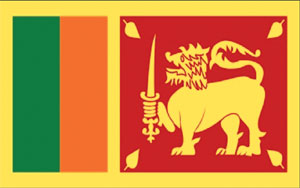 The first Prime Minister of Independent Ceylon(Sri Lanka) D.S.
Senanayake, appointed a national committee for the formulation of a
national flag for the country. The current National flag is an
improvisation of the civil standard of Sri Lanka's last king, Sri
Wickrama Rajasingha. It symbolises the country's culture and heritage
and embodies the spirit of nationality of the people. The first Prime Minister of Independent Ceylon(Sri Lanka) D.S.
Senanayake, appointed a national committee for the formulation of a
national flag for the country. The current National flag is an
improvisation of the civil standard of Sri Lanka's last king, Sri
Wickrama Rajasingha. It symbolises the country's culture and heritage
and embodies the spirit of nationality of the people.
The flag of Sri Lanka, or the Lion Flag as it is also called
comprises a golden coloured lion, holding a kastane sword in its right
fore paw.
The crimson background has a golden bo leaf in each corner. There is
a yellow border around the background, and two vertical stripes to its
left. These vertical stripes are of equal size and in saffron and green,
with the saffron stripe closest to the lion.
Each element on the National Flag has a distinctive symbolic
significance. Do you know what the lion represents? The Sinhalese
ethnicity and the bravery of the Sri Lankan nation.
The four bo leaves represent Metta, Karuna, Mudita and Upekkha; the
four virtues of kindness, friendliness, happiness and equanimity.
The orange stripe represents the Sri Lankan Tamils, the green stripe
represents Sri Lankan Moors, and the maroon background represents the
majority of Sinhalese, like the lion; it was the colour used in early
flags of Sri Lanka by kings. The first time the national flag was
hoisted was on March 3, 1950.
National flower
  The nil manel or the blue lotus /water lilly which has the botanical
name Nympheae stelleta has been the national flower of Sri Lanka since
February 1986. It is found in all parts of the country and grows in
shallow water. The petals of this flower are arranged like a star and
the flat round waterproof leaves are bright green. It symbolises purity
and truth. The nil manel or the blue lotus /water lilly which has the botanical
name Nympheae stelleta has been the national flower of Sri Lanka since
February 1986. It is found in all parts of the country and grows in
shallow water. The petals of this flower are arranged like a star and
the flat round waterproof leaves are bright green. It symbolises purity
and truth.
It has a sweet fragrance and is used for offerings at Buddhist
Temples and rituals for god Vishnu. The fact that these flowers were
popular even in ancient times is evident from the frescoes at Sigiriya.
The women hold these flowers in their hands.
National butterfly
Sri Lanka's largest attractive butterfly - the "Sri Lanka Bird Wing"
(Troides darsius) which is endemic to Sri Lanka was declared as the
National Butterfly in March, 2010 under the recommendations of the
Butterfly Expert Group established under the Environment and Natural
Resources Ministry through its Butterfly Conservation Action Plan.
It is the largest Sri Lankan butterfly with a wingspan spreading
165-180 mm. Its large forewings are glossy black and hindwings bright
yellow with a black margin making it 'hard to miss' when in flight.
"Birdwing is common in rainforest habitats in the wet zone, but is
also seen in the intermediate zone and dry zone.
The Birdwing can even be found in Colombo suburbs. The Birdwing lays
its eggs on the Sap sanda plant and prefers to feed on ixora and pinna
flowers.
National tree
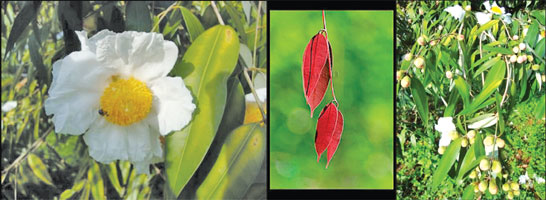 The na tree (iron wood) or (Mesua ferrea or Mesua nagaserium) is a
species in the family Calophyllaceae. It was adopted as as the national
tree of Sri Lanka on February 26 , 1986, by the Cabinet because of the
country's close association with the tree for centuries, both socially
and culturally. The tree which grows to about 30 m high is indigenous to
the lower wet Zone of Sri Lanka. Its beautiful emerging young leaves are
red to yellowish pink and drooping. They mature into a deep green;
simple, narrow, oblong, dark green leaves 7-15 cm long, with a whitish
underside. The na tree (iron wood) or (Mesua ferrea or Mesua nagaserium) is a
species in the family Calophyllaceae. It was adopted as as the national
tree of Sri Lanka on February 26 , 1986, by the Cabinet because of the
country's close association with the tree for centuries, both socially
and culturally. The tree which grows to about 30 m high is indigenous to
the lower wet Zone of Sri Lanka. Its beautiful emerging young leaves are
red to yellowish pink and drooping. They mature into a deep green;
simple, narrow, oblong, dark green leaves 7-15 cm long, with a whitish
underside.
It has white blossoms which are used in herbal medicine and
preparation of perfumes, cosmetics and soaps. The flowers are 4-7.5 cm
diametre, with four white petals and a centre of numerous yellow
stamens.
The timber was used to construct bridges in early times due to its
hardness and durability. However, it is prohibited to fell these trees
today mostly due to its religious value. It is said that the first visit
of the Buddha was to a grove of na trees at Mahiyanganaya and also the
next Buddha (Maithriya) will attain Enlightenment under a na tree. The
plant is named after the heaviness of its timber and cultivated in
tropical climates for its form, foliage, and fragrant flowers. Even
though it is native to tropical Sri Lanka it is also cultivated in
Assam, southern Nepal, Indochina, and the Malay Peninsula.
National bird
  The Sri Lankan junglefowl (Gallus lafayetii) was known during the
colonial era as the Ceylon junglefowl. It is a member of the pheasant
family which is endemic to Sri Lanka. The Sri Lankan junglefowl (Gallus lafayetii) was known during the
colonial era as the Ceylon junglefowl. It is a member of the pheasant
family which is endemic to Sri Lanka.
A very common bird found in the national parks and forests of the
country, it is closely related to the red junglefowl (G. gallus), the
wild junglefowl from which the chicken was domesticated.
The male is much larger than the female, with more vivid plumage and
a highly exaggerated wattle and comband ranges from 66-73 cm (26-29 inc)
in length and 790-1,140 g (1.7-2.5 lb) in weight, essentially resembling
a large, muscular rooster. The male has orange-red body plumage, and
dark purple to black wings and tail. The feathers of the mane descending
from head to base of spine are golden, and the face has bare red skin
and wattles. The comb is red with a yellow centre. The female is much
smaller, at only 35 cm (14 inc) in length and 510-645 g (1.1-1.42 lb) in
weight, with dull brown plumage with white patterning on the lower belly
and breast, ideal camouflage for a ground nesting bird. It lays 2-4 eggs
in a nest. Similar to many members of the pheasant family, the colourful
male plays no part in the incubation of the eggs or rearing of the
young. These duties are performed by the drab and well-camouflaged
female.
The eggs are highly variable in colour but generally are cream with a
yellow or pink tint.
Purple or brownish spots are common. Occasionally a female will
produce red eggs or blotched eggs.
As with most other pheasants, Sri Lanka Junglefowl is a terrestrial
species. It spends most of its time foraging for food by scratching the
ground for various seeds, fallen fruit and insects.
National anthem
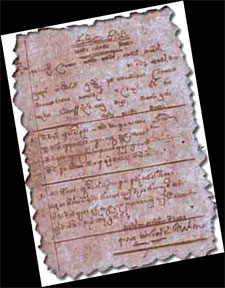 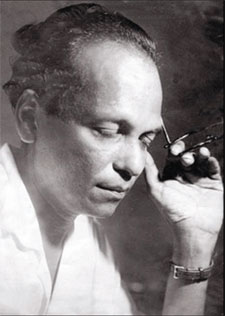 Following Independence in 1948, the need for a national anthem was
strongly felt by the people. Following Independence in 1948, the need for a national anthem was
strongly felt by the people.
As a result a contest was held where Ananda Samarakoon's composition
Namo Namo Matha was chosen as the official national anthem of Sri Lanka.
However, due to a controversy that occurred in the early 1950s, the
opening lines of the national anthem were changed.
The modified opening lines are Sri Lanka Matha-Apa Sri Lanka.
It was only on February 4, 1952 that the first public rendition of
the national anthem took place.
Egodahage George Wilfred Alwis Samarakoon, the composer and musician
and teacher was born on January 13, 1911 to a Christian family in
Padukka. He had his primary and secondary education at Christian
College,Kotte, presently known as Sri Jayewardenepura M.V. Kotte. His
Sinhala guru was Pandit D.C.P. Gamalathge. Namo Namo Mata (composed in
1940, recorded in 1946) was one of Samarakoon's early compositions. It
was nominated as the national anthem and was officially adopted as the
national anthem of the country on November 22, 1951 by a committee
headed by Sir Edwin Wijeyeratne. On April 5, 1962, at the age of
fifty-one he died.
National emblem
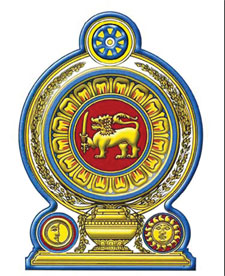 A national emblem symbolically represents a nation. When we were a
British Crown Colony we naturally used the British emblem. We continued
to use it even after the attainment of Independence in 1948. However, on
realising the need to have our own national emblem as we were no longer
a Crown colony of the British, a select committee was appointed to
create a State emblem more suited for Sri Lanka. The new State emblem
includes a lion with a sword in its right front paw surrounded by a
Palapethi open petal design top. Beneath this, there is a strip carrying
the country's name in Sinhala, Tamil and English. A national emblem symbolically represents a nation. When we were a
British Crown Colony we naturally used the British emblem. We continued
to use it even after the attainment of Independence in 1948. However, on
realising the need to have our own national emblem as we were no longer
a Crown colony of the British, a select committee was appointed to
create a State emblem more suited for Sri Lanka. The new State emblem
includes a lion with a sword in its right front paw surrounded by a
Palapethi open petal design top. Beneath this, there is a strip carrying
the country's name in Sinhala, Tamil and English.
After becoming a Republic on May 22, 1972, a new Republican emblem
with an additional portrayal of the punkalasa, dhammachakka, sun, moon
and two sheaves of paddy besides the lion with a sword came into use.
Accordingly the present emblem features a gold lion passant, holding a
sword in its right fore paw (the same lion from the flag of Sri Lanka)
in the centre on a maroon background surrounded by golden petals of a
blue lotus, the national flower of the country.
This is placed on top of a traditional grain vase that sprouts
sheaves of rice grains that circle the border reflecting prosperity.
The crest is the Dharmacakra, symbolising the country's foremost
place for Buddhism and just rule.
Traditional Sinhalese heraldic symbols for the sun and the moon form
the supporters.The national emblem is used by the Sri Lankan Government
in connection with the administration and government of the country.
Facts and pix: Internet |

